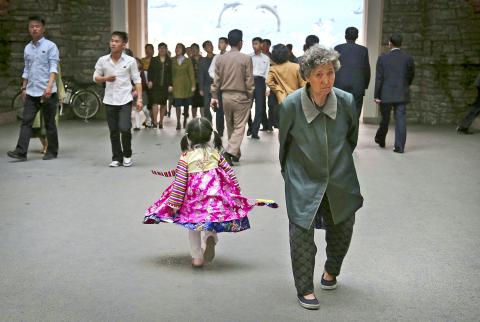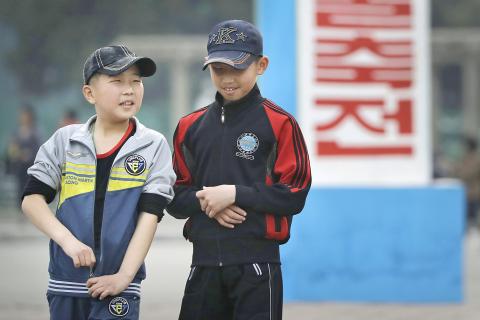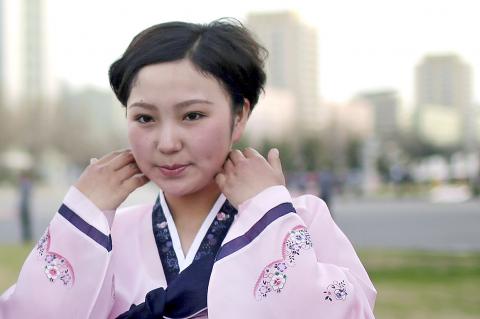She dances beneath portraits of two smiling dictators, a modern young woman in a central Pyongyang plaza who twirls to music calling on North Koreans to die for their leader.
When she speaks, a torrent of reverence tumbles out for North Korea’s ruling family, as if phrases had been plucked at random from a government newspaper: “The revolution of the Great Leader” ... “Laborers trust and venerate Marshal Kim Jong Un.” And as hundreds of students dance behind her in a choreographed display of loyalty, she is adamant about one thing: North Korea, she insists, has no generation gap.
“The spirit of the youth has remained the same as ever!” Ryu Hye Gyong says.

Photo: Wong Maye-E, AP
But look more closely — look beyond her words, beyond the propaganda posters on every street, and the radios playing hymns to the ruling family — and the unspoken reality is far more complicated.
MONEY OVER POLITICS
A 19-year-old university student with a confident handshake and carefully styled hair, Ryu lives in a city that today feels awash in change. There are rich people now in Pyongyang, chauffeured in Mercedes even as most citizens of the police state remain mired in poverty. There’s a supermarket selling disposable diapers. On sidewalks where everyone once dressed in drab Maoist conformity, there are young women in not-quite miniskirts and teenage boys with baseball caps cocked sideways, K-pop style.

Photo: Wong Maye-E, AP
In this profoundly isolated country, a generational divide is quietly growing.
Here, where rulers have long been worshipped as all-powerful providers, young people have grown to adulthood expecting nothing from the regime. Their lives, from professional aspirations to dating habits, are increasingly shaped by a growing market economy and a quietly thriving underground trade in smuggled TV shows and music. Political fervor is being pushed aside by something else: A fierce belief in the power of money.
It’s a complex divide, where some 20-year-olds remain fierce ideologues and plenty of 50-year-olds have no loyalty to the increasingly worried regime. But conversations with more than two dozen North Korean refugees, along with scholars, former government officials and activists, make it clear that young people are increasingly unmoored from the powerful ideology the government long ago placed at the center of every life.

Photo: Wong Maye-E, AP
“When Kim Jong Un speaks, young people don’t listen,” says Han Song Yi, 24, who left the North in 2014, dreaming of pop-music stardom in the South. “They just pretend to be listening.”
In her tight jeans and gold-speckled eyeshadow, Han loves talking about fashion and the K-pop bands she and her friends secretly listened to back home. She can also deconstruct how the sudden emergence of short skirts in her hometown in the autumn of 2012 mirrored not just the ascension of Kim Jong Un, the new leader often photographed with his glamorous wife, but also the political cynicism growing around her.
“North Korea in the past, and North Korea today are so different,” she says.
WEAKENING GRIP?
Nobody in North Korea will talk to an outsider about this, and it’s easy to see why.
Stand at nearly any Pyongyang street corner and reminders of the state’s power are everywhere. Mounted portraits show the first two rulers: Kim Il Sung, who shaped the North into one of the world’s most repressive states, and his son, Kim Jong Il, who created the personality cults that now dominate public life. Immense rooftop signs spell out praise for grandson Kim Jong Un, the ruling party and the military.
The message is unmistakable: “People are always careful about what they say,” Han says.
For generations, propaganda about the Kim family was all that most North Koreans knew, a mythology of powerful but tender-hearted rulers that still suffuses everything from children’s stories to TV shows.
It’s an emotional tug felt by many older North Koreans. In part that’s because they remember the days of relative prosperity, when the state provided food, apartments and clothing.
An economic shift began in the mid-1990s, when Soviet aid ended and devastating floods caused widespread famine. The police state weakened. Smuggling flourished. While the state eventually tightened its hold again, private enterprise just grew.
But to people who came of age after the famine, when it had become clear the regime was neither all-powerful nor all-providing, the propaganda is often just background noise.
“After a while, I stopped paying attention,” says Lee Ga Yeon, who began helping support her family as a teenager during the famine by selling food door to door. “I didn’t even think about the regime anymore.”
That lack of interest frightens the regime, whose legitimacy depends on its ability to remain at the core of life.
“They know that young people are where you get revolutions,” says Hazel Smith, a North Korea scholar at SOAS, University of London and former aid worker in North Korea. “This is the cleavage that the government is worried about.”
‘NO YOUTHFUL ANGER’
Kim Jong Un, who wasn’t even 30 when he came to power after his father’s 2011 death, now faces the challenge of his own generation. On his gentler days, Kim has reached out to young people. There was an increase in youth-oriented rallies after Kim’s ascension, and public pledges of youth loyalty. There’s propaganda now clearly aimed at young people, like the all-woman Moranbong Band, which performs in tight skirts and high heels.
Most of these young people have grown up with at least some access to smuggled DVDs or flash drives, and South Korean soap operas are now beloved, despite being officially banned. To many young Northerners they are windows onto a modern world, nurturing middle-class aspirations while helping change everything from fashion to romance.
Today, young women can be seen on the streets of Pyongyang in tight-fitting blouses and short skirts (though no shorter than 5cm above the knee, Han notes, or party workers can demand you change or pay a fine). Couples can occasionally be spotted holding hands. In a culture where arranged marriages were the norm until very recently, young people now date openly and choose their own spouses.
But while the generational divide has grown, there have been no signs of youthful anger: no university protests or political graffiti. Because the power of the police state remains immense. And because the gap isn’t about politics.
“It’s not about the regime,” says Lee, who now studies literature at one of South Korea’s top universities. “It’s about money.”
Money now courses through North Korea. Experts believe the private sector, from small traders to textile factories, accounts for as much as half of North Korea’s economy. There’s also much more to buy now: battery-powered bicycles, Chinese electronics, solar panels for electricity outages.
“In the past, everybody wanted to be a government official, that was the number-one dream,” says Lee. “But more and more, people know that money can solve everything.”

On April 26, The Lancet published a letter from two doctors at Taichung-based China Medical University Hospital (CMUH) warning that “Taiwan’s Health Care System is on the Brink of Collapse.” The authors said that “Years of policy inaction and mismanagement of resources have led to the National Health Insurance system operating under unsustainable conditions.” The pushback was immediate. Errors in the paper were quickly identified and publicized, to discredit the authors (the hospital apologized). CNA reported that CMUH said the letter described Taiwan in 2021 as having 62 nurses per 10,000 people, when the correct number was 78 nurses per 10,000

As we live longer, our risk of cognitive impairment is increasing. How can we delay the onset of symptoms? Do we have to give up every indulgence or can small changes make a difference? We asked neurologists for tips on how to keep our brains healthy for life. TAKE CARE OF YOUR HEALTH “All of the sensible things that apply to bodily health apply to brain health,” says Suzanne O’Sullivan, a consultant in neurology at the National Hospital for Neurology and Neurosurgery in London, and the author of The Age of Diagnosis. “When you’re 20, you can get away with absolute

May 5 to May 11 What started out as friction between Taiwanese students at Taichung First High School and a Japanese head cook escalated dramatically over the first two weeks of May 1927. It began on April 30 when the cook’s wife knew that lotus starch used in that night’s dinner had rat feces in it, but failed to inform staff until the meal was already prepared. The students believed that her silence was intentional, and filed a complaint. The school’s Japanese administrators sided with the cook’s family, dismissing the students as troublemakers and clamping down on their freedoms — with

As Donald Trump’s executive order in March led to the shuttering of Voice of America (VOA) — the global broadcaster whose roots date back to the fight against Nazi propaganda — he quickly attracted support from figures not used to aligning themselves with any US administration. Trump had ordered the US Agency for Global Media, the federal agency that funds VOA and other groups promoting independent journalism overseas, to be “eliminated to the maximum extent consistent with applicable law.” The decision suddenly halted programming in 49 languages to more than 425 million people. In Moscow, Margarita Simonyan, the hardline editor-in-chief of the